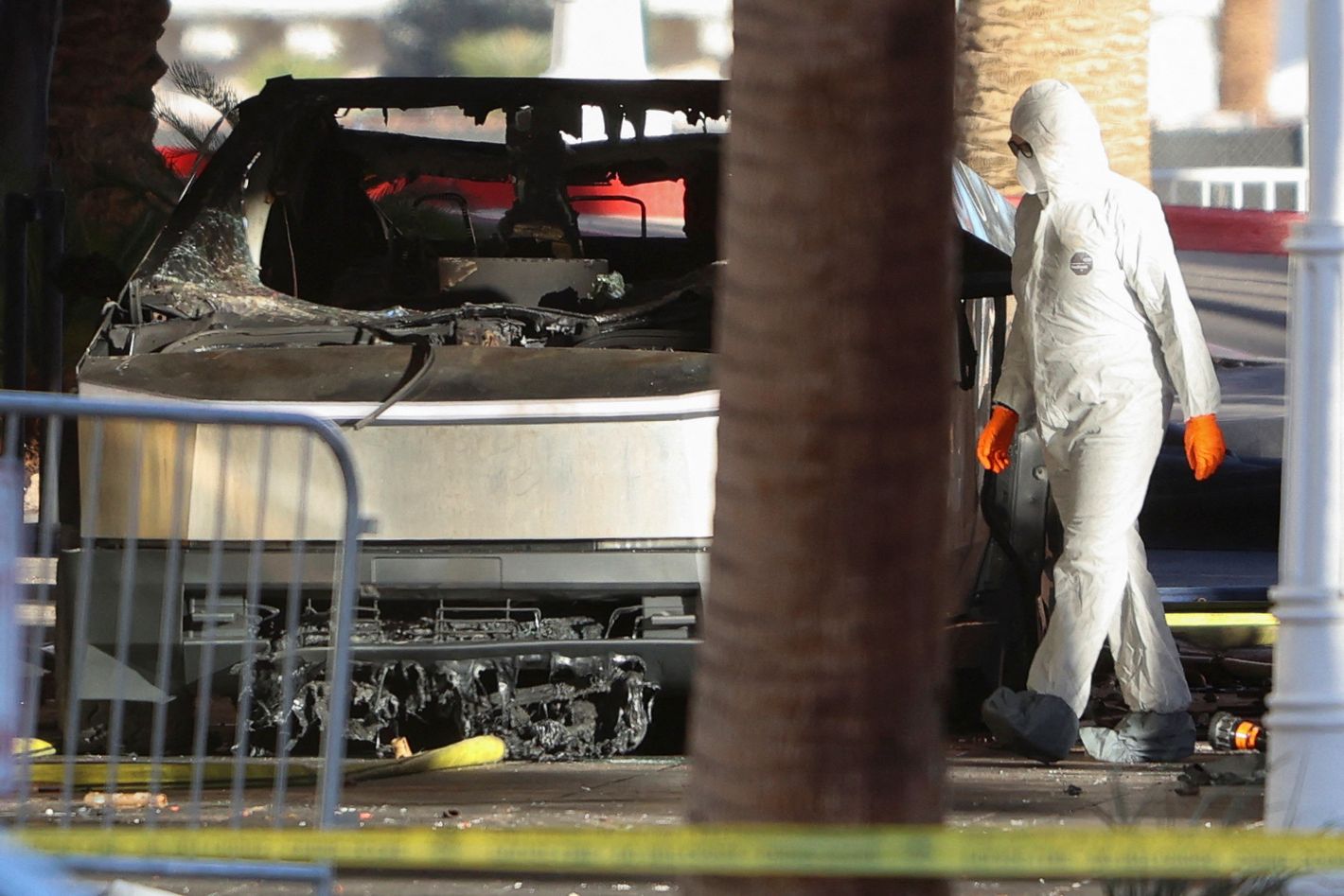Photo: Ronda Churchill/Reuters
In an alarming start to the New Year, a Tesla Cybertruck parked in front of the Trump International Hotel Las Vegas exploded on Wednesday morning, hours after an unrelated terrorist attack in New Orleans. Days later, several questions about the explosion still aren’t fully answered. The driver, 37-year-old Army Special Forces soldier Matthew Livelsberger, shot himself in the head at about the same time the truck blew up. Below is a look at the latest details revealed by authorities and in news reports.
What was the bomber’s motive?
According to information made public so far by officials, Livelsberger rented a Cybertruck on December 28 from the car-sharing app Turo. He then drove it to Las Vegas, where he legally purchased two guns on December 30. After filling the truck with gas canisters and fireworks, he parked it at the Trump International Hotel on January 1 at 8:39 a.m. According to the Clark County Office of the Coroner, he shot himself in the head moments before a detonation system blew up the truck. Seven bystanders received minor injuries from the blast.
In a press conference on Friday afternoon, Las Vegas Metropolitan Police sheriff Kevin McMahill announced that officials found notes on Livelsberger’s phone indicating that he had planned the suicide bombing to draw attention to himself and a variety of his complaints and claims. In one of the notes, Livelsberger said it was time for Americans to “wake up” and that the nation is being led by “weak leadership only interested in themselves.”
“This was not a terrorist attack, it was a wake up call,” the note read. “Americans only pay attention to spectacles and violence. What better way to get my point across than a stunt with fireworks and explosives? Why did I personally do it now? I needed to cleanse my mind of the brothers I’ve lost and relieve my self of the burden of the lives I took.” Officials stated that the letters would be released to the public soon.
Spencer Evans, the FBI special agent in charge, added that Livelsberger “likely suffered from PTSD” and that family issues may be “contributing factors” to the act. He also stressed that this was a tragic suicide by a highly decorated soldier.
The New York Post reports that Livelsberger had left the home he shared with his second wife the day after Christmas when she broke with him following an argument over infidelity. In the days preceding his death, he also reportedly texted with multiple ex-girlfriends. One of them, an Army nurse he dated in 2018, has told reporters that Livelsberger suffered from PTSD and had symptoms of traumatic brain injury but refused to seek therapy, citing the stigma against doing so within the Special Forces.
McMahill and Evans also acknowledged a podcast episode hosted by former Navy SEAL Shawn Ryan that details a purported manifesto emailed by Livelsberger. They said they have not been able to confirm that Livelsberger wrote the email, which includes multiple conspiracy claims. Evans also denied that the FBI was tracking Livelsberger prior to the explosion, which is another claim made in the email.
Why did he do it at a Trump hotel?
It is not yet clear why Livelsberger drove from Colorado Springs to Las Vegas to shoot himself and blow up a rented electric truck in front of a hotel named after the president-elect. Multiple people who knew him have described him as a Trump supporter, while a relative told ABC News that Livelsberger said that Trump “was a soldier’s best friend.”
In the press conference on Friday, Evans said Livelsberger “held no animosity toward the president-elect.” McMahill said that Livelsberger also considered other locations for his act, including the U.S.-Mexico border and the Grand Canyon.
Why did he use a Tesla Cybertruck?
Prior to his death, the Denver Gazette reported, Livelsberger had texted an ex-girlfriend about renting a Cybertruck. “It’s the shit,” he wrote on December 29. “I feel like Batman or Halo.” But investigators have not yet determined why he rented that specific vehicle.
Tesla CEO Elon Musk has said the truck’s design saved lives. “The evil knuckleheads picked the wrong vehicle for a terrorist attack. Cybertruck actually contained the explosion and directed the blast upwards,” Musk wrote on X the day of the explosion. “Not even the glass doors of the lobby were broken.” Authorities have confirmed that the walls of the Cybertruck bed directed the blast up and away from the hotel entrance.
Why did an elite Special Forces soldier make such a weird car bomb?
An Army spokesperson confirmed that Livelsberger was an active-duty sergeant assigned to the Army Special Operations Command and that he was on approved leave. He had served in the Army since 2006, had deployed twice in Afghanistan, and also served in Ukraine, Tajikistan, Georgia, and the Republic of the Congo. He received five bronze stars in his 18 years of service, including one for courage under fire.
The New York Times reports that Livelsberger spent most of his career in the Special Forces, where he would have gotten explosives training. But the rented Cybertruck did not contain typical aspects of a car bomb, including packed-in shrapnel. Officials say the bomb featured consumer-grade fireworks, including mortars, as well as store-bought gas canisters. The explosion did not even break the truck’s windshield.
“The level of sophistication is not what we would expect from an individual with this type of military experience,” ATF special agent Kenneth Cooper told the Times.

